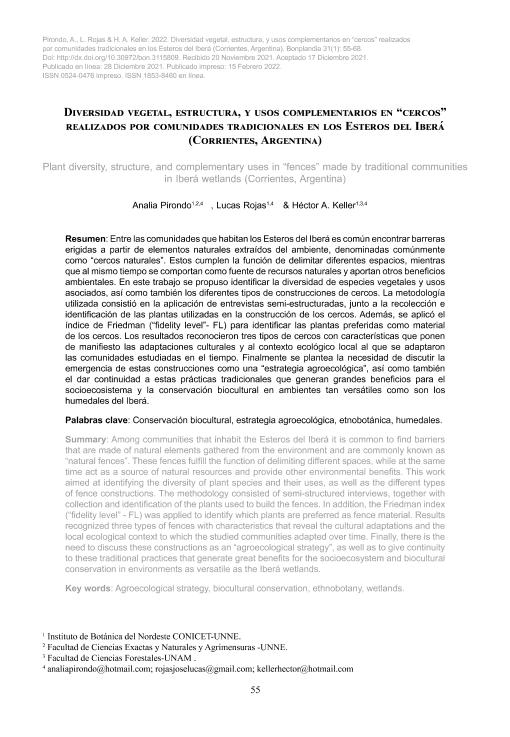Artículo
Entre las comunidades que habitan los Esteros del Iberá es común encontrar barreras erigidas a partir de elementos naturales extraídos del ambiente, denominadas comúnmente como “cercos naturales”. Estos cumplen la función de delimitar diferentes espacios, mientras que al mismo tiempo se comportan como fuente de recursos naturales y aportan otros beneficios ambientales. En este trabajo se propuso identificar la diversidad de especies vegetales y usos asociados, así como también los diferentes tipos de construcciones de cercos. La metodología utilizada consistió en la aplicación de entrevistas semi-estructuradas, junto a la recolección e identificación de las plantas utilizadas en la construcción de los cercos. Además, se aplicó el índice de Friedman (“fidelity level”- FL) para identificar las plantas preferidas como material de los cercos. Los resultados reconocieron tres tipos de cercos con características que ponen de manifiesto las adaptaciones culturales y al contexto ecológico local al que se adaptaron las comunidades estudiadas en el tiempo. Finalmente se plantea la necesidad de discutir la emergencia de estas construcciones como una “estrategia agroecológica”, así como también el dar continuidad a estas prácticas tradicionales que generan grandes beneficios para el socioecosistema y la conservación biocultural en ambientes tan versátiles como son los humedales del Iberá. Among communities that inhabit the Esteros del Iberá it is common to find barriers that are made of natural elements gathered from the environment and are commonly known as “natural fences”. These fences fulfill the function of delimiting different spaces, while at the same time act as a source of natural resources and provide other environmental benefits. This work aimed at identifying the diversity of plant species and their uses, as well as the different types of fence constructions. The methodology consisted of semi-structured interviews, together with collection and identification of the plants used to build the fences. In addition, the Friedman index (“fidelity level” - FL) was applied to identify which plants are preferred as fence material. Results recognized three types of fences with characteristics that reveal the cultural adaptations and the local ecological context to which the studied communities adapted over time. Finally, there is the need to discuss these constructions as an “agroecological strategy”, as well as to give continuity to these traditional practices that generate great benefits for the socioecosystem and biocultural conservation in environments as versatile as the Iberá wetlands.
Diversidad vegetal, estructura, y usos complementarios en “cercos” realizados por comunidades tradicionales en los Esteros del Iberá (Corrientes, Argentina)
Título:
Plant diversity, structure, and complementary uses in “fences” made by traditional communities in Iberá wetlands (Corrientes, Argentina)
Fecha de publicación:
04/2022
Editorial:
Consejo Nacional de Investigaciones Científicas y Técnicas. Centro Científico Tecnológico Conicet - Nordeste. Instituto de Botánica del Nordeste
Revista:
Bonplandia
ISSN:
0524-0476
e-ISSN:
1853-8460
Idioma:
Español
Tipo de recurso:
Artículo publicado
Clasificación temática:
Resumen
Palabras clave:
AGROECOLOGICAL STRATEGY
,
BIOCULTURAL CONSERVATION
,
ETHNOBOTANY
,
WETLANDS
Archivos asociados
Licencia
Identificadores
Colecciones
Articulos(IBONE)
Articulos de INST.DE BOTANICA DEL NORDESTE (I)
Articulos de INST.DE BOTANICA DEL NORDESTE (I)
Citación
Pirondo, Analia; Rojas, José Lucas; Keller, Hector Alejandro; Diversidad vegetal, estructura, y usos complementarios en “cercos” realizados por comunidades tradicionales en los Esteros del Iberá (Corrientes, Argentina); Consejo Nacional de Investigaciones Científicas y Técnicas. Centro Científico Tecnológico Conicet - Nordeste. Instituto de Botánica del Nordeste; Bonplandia; 31; 1; 4-2022; 55-68
Compartir
Altmétricas




